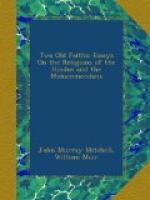[12] “These two personages [Indra and Varuna] sum up the two conceptions of divinity, between which the religious consciousness of the Vedic Aryans seems to oscillate.”—Bergaigne, La Religion Vedique, vol. iii, p. 149.
[13] The meaning of the term is not quite certain. Sessions, or Instructions, may perhaps be the rendering. So Monier Williams.
[14] For example, Wordsworth:
“Thou,
Thou alone
Art everlasting, and the blessed
Spirits
Which Thou includest, as the
sea her waves.”
—Excursion,
book iv.
[15] Or, the thing that really is—the [Greek: ontos on].
[16] Ekamadvitiyam.
[17] This illustration is in the mouth of every Hindu disputant at the present day.
[18] Barth, p. 75.
[19] Ekamadvitiyam.
[20]
Volui
tibi suaviloquenti
Carmine Pierio rationem exponere
nostram
Et quasi Musaeo dulci contingere
melle.
[21] Dr. J. Muir, in North British Review, No. xlix, p. 224.
[22] Miscellaneous Writings (Macmillan, 1861), vol. i, p. 77.
[23] But the truth is that every man is accounted a good Hindu who keeps the rules of caste and pays due respect to the Brahmans. What he believes, or disbelieves, is of little or no consequence.
[24] Yaska, probably in the fifth century B.C.
[25] Weber thinks that Christian elements may have been introduced, in course of time, into the representation.
[26] His Ramayana was written in Hindi verse in the sixteenth century.
[27] When Jhansi was captured in the times of the great mutiny English officers were disgusted to see the walls of the queen’s palace covered with what they described as “grossly obscene” pictures. There is little or no doubt that these were simply representations of the acts of Krishna. Therefore to the Hindu queen they were religious pictures. When questioned about such things the Brahmans reply that deeds which would be wicked in men were quite right in Krishna, who, being God, could do whatever he pleased.
[28] Born probably in 1649.
[29] Raja Narayan Basu (Bose), in enumerating the sacred books of Hinduism, excluded the philosophical systems and included the Tantras. He was and, we believe, is a leading man in the Adi Brahma Somaj.
[30] Barth, as above, p. 202.
[31] So writes Vans Kennedy, a good authority. The rites, however, vary with varying places.
[32] Asiatic Researches, v, p. 356.
[33] Cicero.
[34] We learned from his own lips that among the books which most deeply impressed him were the Bible and the writings of Dr. Chalmers.
[35] See Life of Mohammed, p. 138. Smith & Elder.
[36] Life of Mohammed, p. 172, where the results are compared.




